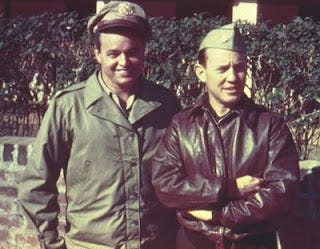A little over a decade ago, we lost the last half of one of the great teams of WWII; a local boy and father of USAF Special Operations. If what they did took place in Europe, they would have had a movie made out of it. As it took place in the Burma theater - well - at least we can cover it here.
John R. Alison, a World War II fighter pilot who helped lead a daring and unprecedented Allied air invasion of Burma, has died, a son said Wednesday.
The retired Air Force major general and former Northrop Corp. executive died of natural causes Monday at his home in Washington, John R. Alison III said.
Alison's wartime achievements included seven victories, six in the air, qualifying him as an ace, according to the Air Force Association, an independent organization in Arlington, Va., that promotes public understanding of aerospace power.
Operation THURSDAY began on March 5, 1944, when the first C-47 launched from India towing two overloaded gliders filled with Wingate's troops, equipment, and supplies. A total of 26 transports towing gliders comprised the first wave. The gliders, carrying from 1,000 to 2,000 pounds of excess weight, strained the C-47 tow planes and ropes and caused significant problems. With eight of the first wave of C-47s each losing a glider, Colonel Cochran decided to limit one glider to each remaining transport. This decision allowed the air commandos to successfully deliver Wingate's initial and succeeding forces to the jungle clearings over 200 miles behind Japanese lines in Burma.
During the first day the strip, designated "Broadway," was improved so transport, glider, and liaison aircraft could land safely. They brought supplies, equipment and reinforcements, and evacuated the injured. A second strip, opened by glider assault, relieved congestion at Broadway. Airlift inserted almost 10,000 men, well over 1,000 mules, and approximately 250 tons of supplies. Casualties from the high-risk, untested concept, including missing, were less than 150, and for the first time in military history aircraft evacuated all killed, wounded, and sick from behind enemy lines.
The air commandos also protected the British ground forces by harassing the Japanese. This harassment, conducted by P-51s and B-25s equipped with a 75mm cannon in the nose and 12 .50 caliber machine guns, included bombing bridges, strafing and bombing parked aircraft, air-to-air combat, and destroying the communications, transportation, and military infrastructure.
Wait, who is that Cochran character? Funny you should ask.
See that guy to the left - that was then Lt. Col. Philip Cochran, USAAC. He passed away in 1979. He was - wrap this around your head PCO pipeline guys and gals - 1st USAAF Air Commando Group Co-Commander with Alison. Co-Commander. I guess if Hap Arnold tells you, you work it out.
See him and his men in action below. Remember - he was only 34 in 1944. Alison was 32.
Remember that next time you dismiss the capabilities and opinion of your senior LTs and junior LCDR.
Ponder a lot.
One more bit about Cochran - talk about character.
Cochran was the inspiration behind characters in the Terry and the Pirates and Steve Canyon by Milton Caniff.
...
Cochran dated actress Betty White in the early 1960s after being introduced by Jack Paar. White declined his marriage proposal; later dating Cochran and her future husband Allen Ludden simultaneously, until her romance with Ludden became serious.
Hat tip GOH. First posted June 2011.
UPDATE: If you are interested in this, you need to read William Y'Blood's Air Commandos Against Japan by USNI Press. Our friend B.J. Armstrong reviewed it a few years ago at The Journal of Military History.




